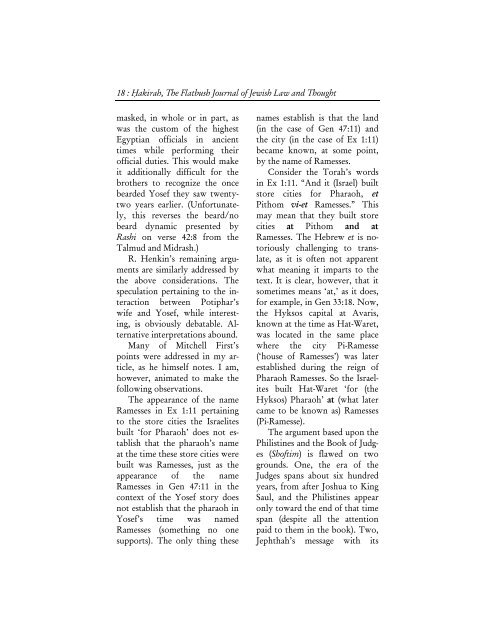the letter. - Hakirah.org
the letter. - Hakirah.org
the letter. - Hakirah.org
You also want an ePaper? Increase the reach of your titles
YUMPU automatically turns print PDFs into web optimized ePapers that Google loves.
18 : Hạkirah, The Flatbush Journal of Jewish Law and Thought<br />
masked, in whole or in part, as<br />
was <strong>the</strong> custom of <strong>the</strong> highest<br />
Egyptian officials in ancient<br />
times while performing <strong>the</strong>ir<br />
official duties. This would make<br />
it additionally difficult for <strong>the</strong><br />
bro<strong>the</strong>rs to recognize <strong>the</strong> once<br />
bearded Yosef <strong>the</strong>y saw twentytwo<br />
years earlier. (Unfortunately,<br />
this reverses <strong>the</strong> beard/no<br />
beard dynamic presented by<br />
Rashi on verse 42:8 from <strong>the</strong><br />
Talmud and Midrash.)<br />
R. Henkin’s remaining arguments<br />
are similarly addressed by<br />
<strong>the</strong> above considerations. The<br />
speculation pertaining to <strong>the</strong> interaction<br />
between Potiphar’s<br />
wife and Yosef, while interesting,<br />
is obviously debatable. Alternative<br />
interpretations abound.<br />
Many of Mitchell First’s<br />
points were addressed in my article,<br />
as he himself notes. I am,<br />
however, animated to make <strong>the</strong><br />
following observations.<br />
The appearance of <strong>the</strong> name<br />
Ramesses in Ex 1:11 pertaining<br />
to <strong>the</strong> store cities <strong>the</strong> Israelites<br />
built ‘for Pharaoh’ does not establish<br />
that <strong>the</strong> pharaoh’s name<br />
at <strong>the</strong> time <strong>the</strong>se store cities were<br />
built was Ramesses, just as <strong>the</strong><br />
appearance of <strong>the</strong> name<br />
Ramesses in Gen 47:11 in <strong>the</strong><br />
context of <strong>the</strong> Yosef story does<br />
not establish that <strong>the</strong> pharaoh in<br />
Yosef’s time was named<br />
Ramesses (something no one<br />
supports). The only thing <strong>the</strong>se<br />
names establish is that <strong>the</strong> land<br />
(in <strong>the</strong> case of Gen 47:11) and<br />
<strong>the</strong> city (in <strong>the</strong> case of Ex 1:11)<br />
became known, at some point,<br />
by <strong>the</strong> name of Ramesses.<br />
Consider <strong>the</strong> Torah’s words<br />
in Ex 1:11. “And it (Israel) built<br />
store cities for Pharaoh, et<br />
Pithom vi-et Ramesses.” This<br />
may mean that <strong>the</strong>y built store<br />
cities at Pithom and at<br />
Ramesses. The Hebrew et is notoriously<br />
challenging to translate,<br />
as it is often not apparent<br />
what meaning it imparts to <strong>the</strong><br />
text. It is clear, however, that it<br />
sometimes means ‘at,’ as it does,<br />
for example, in Gen 33:18. Now,<br />
<strong>the</strong> Hyksos capital at Avaris,<br />
known at <strong>the</strong> time as Hat-Waret,<br />
was located in <strong>the</strong> same place<br />
where <strong>the</strong> city Pi-Ramesse<br />
(‘house of Ramesses’) was later<br />
established during <strong>the</strong> reign of<br />
Pharaoh Ramesses. So <strong>the</strong> Israelites<br />
built Hat-Waret ‘for (<strong>the</strong><br />
Hyksos) Pharaoh’ at (what later<br />
came to be known as) Ramesses<br />
(Pi-Ramesse).<br />
The argument based upon <strong>the</strong><br />
Philistines and <strong>the</strong> Book of Judges<br />
(Shoftim) is flawed on two<br />
grounds. One, <strong>the</strong> era of <strong>the</strong><br />
Judges spans about six hundred<br />
years, from after Joshua to King<br />
Saul, and <strong>the</strong> Philistines appear<br />
only toward <strong>the</strong> end of that time<br />
span (despite all <strong>the</strong> attention<br />
paid to <strong>the</strong>m in <strong>the</strong> book). Two,<br />
Jephthah’s message with its
















